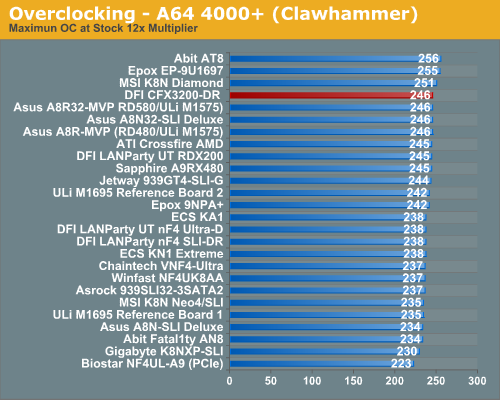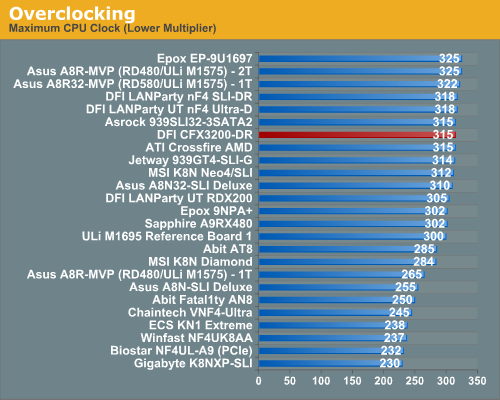DFI CFX3200-DR: ATI RD580 Tweak Attack
by Wesley Fink on May 8, 2006 12:05 AM EST- Posted in
- Motherboards
Overclocking
Maximum overclock data was added to our performance graphs to allow a visual comparison of the overclocking capabilities of tested boards. The values represent the highest stable overclock achieved with a standardized air-cooling setup on an AMD 4000+ CPU. For more details on the specific overclocking abilities of a specific board please refer to the Overclocking and Memory Stress Test section of individual board reviews.

The overclocking performance of the DFI CFX3200-DR was what we have come to expect from DFI, in a word outstanding. Overclocking reached 315 at a 1T Command Rate at the reduced multiplier. We were able to run SuperPI and all 3D tests at the 315 setting without crashes. While this is not the highest overclock we have ever achieved, we consider boards that reach 300 or above to be essentially the same in our tests. As memory has moved from Samsung TCCD in 512MB DIMMs to other memory chips in 1GB DIMMs, the DDR overclock needs have moved downward. Any board that can do 280 or so at a reduced multiplier can probably run a current 2GB DDR memory kit at the fastest "1:1" speeds it can achieve.
Note that we don't conduct extensive testing at reduced memory multipliers, due to time constraints. It is possible that boards will reach higher HTT bus speeds with lowered memory bandwidth, and that's something we've discussed in a couple socket 939 overclocking articles. Lower memory ratios are particularly useful when using 1GB DDR DIMMs or when simply trying to increase CPU speed while using value RAM. In general, higher CPU speeds have more of an impact on AMD socket 939 system performance than increased memory bandwidth or lower timings. Balancing timings, memory bandwidth, and CPU speed to achieve maximum performance is something that requires a lot of time and testing for each individual CPU/system. However, with AM2 around the corner the performance/overclocking rules will change again.
Performance at the stock 12X multiplier matched the highest stock overclock of 246 we have tested with this CPU. This is more a test of the limits of this CPU than a test of the overclocking capabilities of the motherboard. Having said that, only a very few boards can squeeze this highest 246 from our test CPU, so performance in this test does reflect the stability of the board as an overclocking platform. Both results are among top of our overclocking results charts. We would expect nothing less from this DFI board. It is possible even higher overclocks can be achieved on air by those who are willing to master the huge array of tweaks on this DFI CFX3200-DR. Frankly we could have spent weeks exploring all the combinations of adjustments that can be achieved. This incredible array of options will likely make setup guides for the DFI CFX3200 some of the most popular articles on overclocking Forums.










25 Comments
View All Comments
rqle - Monday, May 8, 2006 - link
"...breathlessly waiting for DFI's AM2 and Conroe motherboards."Great board, but not sure where this new mainboard will fit in since AM2 is coming, many can opt for the nforce expert if they need a board before AM2.
hoping AM2 version is in the works and will be release soon as well.
electronox - Monday, May 8, 2006 - link
*sigh*as far as gaming benchmarks go, what we really need to learn to do is to focus on the lowest framerates rather than the highest framerates (or even the average framerate). fink, anand, and co., you guys offer a progressive tech-journalism and no doubt have thought about what FPS performance really means.
in its most important application, FPS performance means the ability to convey a smooth, fluid visual experience without noticeable dips or jerks in motion. sadly, with the way things are marketed now, the overall fluidity of gaming is sacrificed to reach those peak framerates we all obsess about in our benchmarking suites.
as a long time gamer and enthusiast-sector consumer, i wish such high profile websites as yours would pay more attention to the worst parts of FPS gaming - the parts of the game where the intensity of in-game content is notched up, but often our video settings must be turned down in order to prevent epileptic siezures. such media attention might, in turn, lead industry developers to optimize their drivers for this exceedingly common problem which, in my opinon, is just as easily quantifiable and ever bit as important as average FPS performance.
my thoughts, electronox.
Dfere - Monday, May 8, 2006 - link
I have to agree. I make good money, but I no longer have the time to play with bleeding edge components and do modding. I know this is an enthusiast site, but at least for me , and I think a large amount of readers, an analysis of the max you might get out of a bleeding edge system is not all the value your site brings. A lot of posts by the readers show they have mid range systems. Thus I can only agree that an analysis of the FPS "issues" described above with a mid range system would help readers identify what would best go with their current system, not just a top of the line upgrade. I know your testing tries to determine , for example, CPU limits or GPU limits...... but it really only does so on bleeding edge systems..... and these comments were already mirrored in the latest AGP vid card releases......(why compare a new AGP card with new processor when most AGP owners have 754 systems.... etc)JarredWalton - Monday, May 8, 2006 - link
I think it all depends on what game you're talking about, and how the impact is felt in the fluidity of the FPS score. These days, the vast majority of first-person shooters have a pretty consistent FPS, at least in normal gaming. In benchmarks, you're often stressing the games in a somewhat unrealistic sense -- playing back a demo at three or four times the speed at which it was recorded. Why does that matter? Well, depending on the game engine, loading of data can occur in the background without actually slowing performance down much, if at all. In a time demo, you don't generally get that capability, since everything moves much faster.There are several other difficulties with providing minimum frame rates. Many games don't report instantaneous frames per second and only provide you with the average score. (Doom 3, Quake 4, Call of Duty 2, Half-Life 2, Day of Defeat: Source all generate scores automatically, but don't provide minimum and maximum frame rates.) If we notice inconsistent frame rates, we do generally comment on the fact. About the only game where I still notice inconsistent frame rates is Battlefield 2 with only 1GB of RAM -- at least on a system of this performance level. (I suppose I should throw in Oblivion as well.)
Sure, we could use tools like FRAPS together more detailed information, but given that there's a limited amount of time to get reviews done, would you rather have fewer games with more detailed stats, or more games with average frame rates? Realistically, we can't do both on every single article. Our motherboard reviews try to stay consistent within motherboards, our processor reviews do the same within CPU articles, and the same goes with graphics cards and other areas. If we have an article where we look at results from one specific game, we will often use that to establish a baseline metric for performance, and readers that are interested in knowing more about the benchmark can refer back to that game article.
Average frame rates are not the be-all, end-all of performance. However, neither are they useless or meaningless. we run into similar problems if we report minimum frame rates -- did the minimum frame rate occur once, twice, frequently? As long as people understand that average frame rates are an abstraction representing several layers of performance, than they can glean meaning from the results. You almost never get higher average frame rates with lower minimum frame rates, or conversely lower average frame rates with higher minimum frame rates -- not in a single game. In the vast majority of benchmarks, an increase in average frame rate of 10 FPS usually means that minimum frame rates have gone up as well -- maybe not 10 FPS, but probably 7 or 8 FPS at least.
In the end, without turning every article into a treatise on statistics, not to mention drastically increasing the complexity of our graphs, it's generally better to stick with average frame rates. Individual articles may look at minimum and maximum frame rates as well, but doing that for every single article that uses a benchmark rapidly consumes all of our time. Are we being lazy, or merely efficient? I'd like to think it's the latter. :-)
Regards,
Jarred Walton
Hardware Editor
AnandTech.com
OvErHeAtInG - Monday, May 8, 2006 - link
Good answer :) Also I think that minimum framerates (while very important in gameplay) are much more impacted by the videocard used. With a motherboard review, we're much more concerned with overall performance, which is exactly what you gave us with the avg. framerate numbers...